| | Crop characteristics | Symptoms of yellows diseases | Causes of yellows diseases | The disease cycle | Management of yellows diseases
Trends in crop diversification on the Canadian prairies have resulted in the increased production of exotic herbs, spices, essential oils and medicinal plants. With these new specialty crops have come unique disease and pest problems, some of which were previously rare or unknown on the prairies.
One example is the so-called "yellows" diseases of echinacea, monarda and caraway. Recognizing the symptoms of these diseases and understanding the basic biology of the infectious agents that cause them is fundamental to developing an effective pest management program. But first, it helps to know a bit about the origins of these crops and what they should look like in a healthy condition.
Crop Characteristics
Echinacea
Also known as purple coneflower, echinacea is a member of the aster family (Asteraceae) and is native to North America. Common purple coneflower (Echinacea purpurea (L.) Moench. syn. Rudbeckia purpurea(L.) and narrow-leaved purple coneflower (E. angustifolia DC.) are the two major species grown commercially in Alberta, primarily as medicinal plants. An extract from the roots is used to strengthen the human immune system and has recently gained popularity in the health food market.
Echinacea plants have large, attractive flowers, are easy to grow, and can withstand high temperatures and humidities. Healthy echinacea plants produce single, long-stalked, terminal flower heads up to 15 cm in diameter. As shown in Figure 1, the head has a prominent, cone-shaped centre of brownish-red disk flowers surrounded by petal-like, purple-rose ray flowers. The plants provide a profusion of showy blooms borne in succession for two months or more in late summer. Echinacea is also grown as a garden ornamental and for cut flowers.
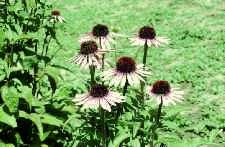
Figure 1. Healthy echinacea flowers
Monarda
Monarda (Monarda fistulosa L.), also known as wild bergamot, is a biennial or perennial member of the mint family (Labiatae) and is indigenous from Quebec to British Columbia. During the last decade, it has been grown commercially in Manitoba and Alberta, primarily as an essential oil crop. Monarda produces high quality geraniol, an essential oil used in perfumes and other scented consumer products. Healthy plants produce 5 cm long, showy, rose-purple, fragrant flowers crowded in solitary, terminal heads as seen in Figure 2. Monarda is also grown as a garden ornamental.
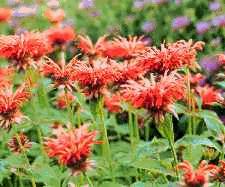 
Figure 2. Healthy monarda flowers with five-lobed calyxes
Caraway
Caraway (Carum carvi L. ), a member of the carrot family (Umbelliferae), is native to Europe and is naturalized in North America. The crop is grown as a seed spice to flavour food and also as a source of oil. Caraway seed contains 3 to 5 per cent essential oil, with carvone and limonene being the principal constituents. Caraway oil is used in the food, cosmetic and pharmaceutical industries.
Caraway can be either an annual or biennial herb. Annual caraway, also known as spring caraway, is very late maturing, and its seed quality and yield have been low. Biennial caraway - which is the major type being grown commercially in the prairies - provides the highest yields. It requires a second growing season to produce seed and can be sown with a nurse crop, e.g. field pea, lentil or coriander, to obtain some return during the establishment year.
In the first year of growth, biennial caraway produces bushy green foliage about 20 cm in height and a tuberous root. In the second and subsequent years, the plant starts to flower by late June, then sets seed which is ready for harvest by early August. Healthy plants have erect, branching stems and can grow 55 to 75 cm high. Leaves are compound with thread-like divisions. The flower is white and borne in clusters as seen in Figure 3. Seeds are ovate to oblong and somewhat ribbed.
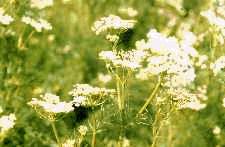
Figure 3. Healthy caraway flowers
Symptoms of Yellows Diseases
Affected plants generally show leaf yellowing, reddening and stunting in the early stages of disease development. See Figure 4. The yellowing symptom can be quite striking, and the name "yellows" is often used to describe these diseased plants. Plants with yellows sometimes have extremely numerous, small, branched, axillary shoots coming from the stem nodes, giving them a bunchy or witches'-broom appearance as shown in Figure 5.
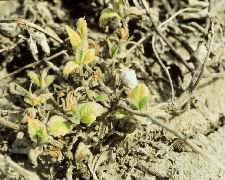 | 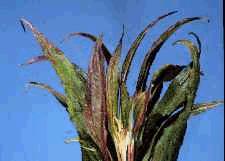 |
| Figure 4. Phytoplasma-infected monarda plant | Figure 5. A phytoplasma-infected echinacea plant with buncy, red leaves |
In later stages of symptom development, infected flowers may change into vegetative, leaflike structures (virescence and phyllody) and, consequently, fail to produce seeds. Please see Figures 6, 7 and 8. Yellows can also reduce winter hardiness, and it often kills affected plants.
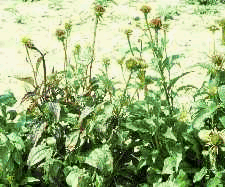 | 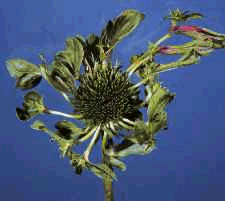 |
Figure 6. Phytoplasma-infected echinacea
plants showing abnormal flower development | Figure 7. Ray and disk flowers of a phytoplama-infected echinacea plant have turned green and leaflike |
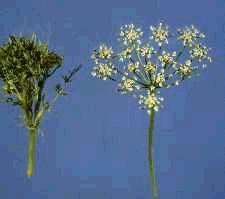 |  |
| Figure 8. Phytolasma-infected caraway flower heat (left) showing bunching, rosetting and malformation of floral organs (virescence and phyllody). Healthy head (right)has white flowers bone in clusters |  |
 |  |
Causes of Yellows Diseases
Plant pathogenic microorganisms called phytoplasmas are the major cause of yellows diseases in plants. Phytoplasmas are also sometimes called mycoplasmas or mycoplasma-like organisms (MLOs) and are smaller than bacteria but larger than viruses. They are responsible for over 200 diseases in a variety of plants. Of these, the so-called "yellows" diseases are the most important group and include maladies such as aster yellows of vegetables, forage legumes and herbaceous ornamentals, yellows of ash and elm, and lethal yellowing of coconut palm.
Phytoplasmas can only survive and reproduce in live plant tissue and cannot be isolated and cultured using conventional laboratory methods. This characteristic makes them difficult to detect and identify. Transmission electron microscopy has been used to observe the ultrastructural characteristics of phytoplasmas and to demonstrate their presence in the sugar-conducting vessels (phloem) of host plants. Examination of ultrathin sections of leaf veins from affected leaves and flowers may reveal large numbers of phytoplasma bodies in the phloem. See Figure 9. These bodies are polymorphic structures surrounded by single membranes, lack cell walls, and contain some nucleic acid (DNA). Recent advances in molecular biology, e.g. DNA sequence comparison, have aided in phytoplasma identification.
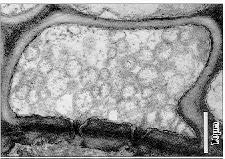
Figure 9. Transmission electron micrograph of a ultrathin section
of the sieve element of the leaf midrib showing a large number of
phytoplasmas (bar=1 micrometre(Ám)=1 millionth of a metre).
Note the wide variation in sizes. Most phytoplasma bodies are oval
to spherical in shape
In Alberta, the aster yellows and witches' broom phytoplasmas are the most widespread and economically important members of this group of pathogens. Scientists have yet to confirm whether it is one of these or yet another type of phytoplasma causing the yellows diseases of echinacea, monarda and caraway described in this factsheet.
The Disease Cycle
Phytoplasmas are transmitted between plants primarily by phloem-feeding leafhoppers (Insecta: Homoptera: Cicadellidae) as seen in Figure 10. These insects have a well-developed sensory system that enables them to reject unsuitable host plants without sampling the sap. They usually transmit phytoplasmas most efficiently to plants preferred for feeding. Leafhoppers feed on a variety of plants and can spread phytoplasma pathogens from wild to cultivated plants and vice versa. Infected biennial and perennial plants may allow phytoplasmas to persist from one year to another in fields and natural areas.
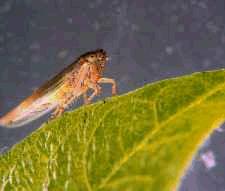
Figure 10. A leafhopper can transmit phytoplasmas efficiently to the plants it feeds on .
In Alberta, leafhoppers can survive through the winter as eggs and appear as early as May. They can also migrate into the province from eastern and southern areas bringing phytoplasmas with them. Therefore, the incidence of phytoplasma diseases often depends upon the abundance and time of migration of leafhoppers from infested to healthy plants. Traditional field crops, such as alfalfa and potato, may serve as symptomless carriers of phytoplasma pathogens and also harbour adult leafhoppers, which could transmit primary inoculum to adjacent plantings of specialty crops.
Management of Yellows Diseases
An integrated strategy, focussing on both the pathogen and the vector, must be followed to successfully manage phytoplasma diseases in susceptible crops.
Susceptible specialty crops should not be planted close to fields of forage legumes or other perennial crops affected by phytoplasma diseases. Care should also be taken to control perennial weeds that may harbour phytoplasmas and/or leafhoppers both in susceptible crops and in adjacent fields and around their margins. Specialty crops and surrounding fields and headlands should be regularly monitored for leafhoppers. Keeping leafhopper populations low is an important means of controlling phytoplasma diseases. Registered insecticides can be used to control leafhoppers in some situations. Development of resistant cultivars is the most promising method for controlling phytoplasma diseases in plants, but little effort has been devoted to breeding specialty crops with resistance to phytoplasmas. Echinacea angustifolia, with its densely pubescent foliage and stems, is less favourable for leafhopper feeding than E. purpurea, which has little or no pubescence. In Alberta, E. angustifolia has exhibited a lower incidence of yellows disease than E. purpurea in field plots. Tetracycline and some other antibiotics have been used to alleviate phytoplasma infections in high-value perennial plants, such as fruit and amenity trees, but their use is not economical in field crops.
Prepared by:
Sheau-Fang Hwang
Alberta Agriculture and Food
Edmonton, Alberta
Kan-Fa Chang
Alberta Agriculture and Food
Lacombe, Alberta
Ron Howard
Alberta Agriculture and Food
Brooks, Alberta
Source: Agdex 630-1. |
|